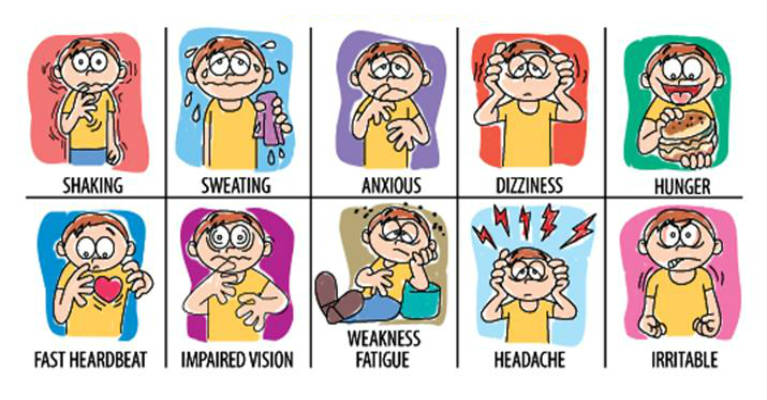Hypoglycemia Management
Hypoglycemia is a fall in blood sugar level that exposes a patient to potential harm and there can be no single numerical definition of hypoglycemia for all patients and situations. In clinical practice, a glucose of 70-80mg/dL is used as the clinical alert or threshold value for initiating treatment for hypoglycemia (Abraham et al., 2018). This hypoglycemia treatment threshold is defined by age:
- Children 1-5 years of age: <80 mg/dL
- Children >6 years of age: <70 mg/dL
- Taking too much insulin (intentional or unintentional)
- Eating fewer carbohydrates than what was dosed for
- Heavy/intense or prolonged physical activity
- Drinking alcohol
- Gastrointestinal illness leading to vomiting and poor carbohydrate absorption
- Celiac disease and other malabsorptive gastrointestinal conditions
- Addison’s disease or Hyperthyroidism/Grave’s disease

- Syncope
- Seizures
- Coma
- Death
This may occur when serum blood glucose is <35mg/dL.
- Check a blood sugar 15-20 minutes after giving glucose
- 15 minutes is about the time it takes ingested carbohydrates to affect systemic blood sugars.
- Checking a blood sugar before 15 minutes is too soon as there has not been enough time for the ingested carbohydrates to take effect. This can lead to the erroneous administration of more carbohydrates and subsequent hyperglycemia.
- 15 minutes is about the time it takes ingested carbohydrates to affect systemic blood sugars.
- If BG is still <90mg/dL after 15-20 minutes, then repeat treatment with the appropriate amount of carbohydrates (Figure 2).

- Accomplished by using a source of rapid-acting carbohydrates (e.g. juice, non-diet soda, glucose tabs, etc.).
- Only used for patients who are alert and able to eat or drink by mouth safely
- Approximately 0.3g/kg of carbohydrates is needed for treatment which is equivalent to:
- 5-10g of rapid-acting carbohydrate for a child <30kg (Aged 1-5 years old)
- 2-3 oz of juice or non-diet soda
- 2-3 oz of applesauce
- 10-15g of rapid-acting carbohydrate for a child >30kg (Age > 6 years old)
- 3-4 oz juice or non-diet soda
- 3-4 glucose tabs
- 5-10g of rapid-acting carbohydrate for a child <30kg (Aged 1-5 years old)
IV Replacement or Glucagon for Moderate to Severe Hypoglycemia (Emergency Treatment):
- For children with severe hypoglycemia or those who are unable to take rapid-acting carbohydrates by mouth (e.g., extremely irritable, refuse, lethargic, unconscious, seizing, etc.), treatment of hypoglycemia requires either:
- IV Dextrose Bolus (D10 via peripheral IV or D12.5-D50 via central access line)
- D10 boluses:
- 0.5g/kg (=2cc/kg) > 8 years old
- 0.25g/kg (=1cc/kg) < 8 years old
- D50 bolus:
- 0.5g/kg (=1cc/kg) –> higher risk for rebound hyperglycemia
- D10 boluses:
- Glucagon – given IV or by IM injection (ideal if no IV access)
- 1mg for patients >25 kg
- 0.5mg for patients <25 kg
- IV Dextrose Bolus (D10 via peripheral IV or D12.5-D50 via central access line)
Maintain IV access on all diabetes patients in the inpatient setting so that severe hypoglycemia, if it occurs, can be quickly addressed with an IV D10 bolus.
Glucagon is usually effective in treating severe hypoglycemia by releasing endogenous glucose from glycogen stores (Figure 3). However, it is reserved as a “last resort rescue medication” in the hospital setting when patients do not have IV access as it causes significant nausea and possible vomiting as a side effect.

Bibliography:
- Abraham MB, Jones TW, Naranjo D, Karges B, Oduwole A, Tauschmann M, Maahs DM. ISPAD Clinical Practice Consensus Guidelines 2018: Assessment and management of hypoglycemia in children and adolescents with diabetes. Pediatr Diabetes. 2018 Oct;19 Suppl 27:178-192. doi: 10.1111/pedi.12698. PMID: 29869358.
Figures:
- Figure 2: This figure was created by Dr. Tuttle using the following icons: “Juice icons” by Smashicons, “15 minutes icon” by Freepik, “diabetes icons” by Freepik, and “Righ icons” by kliwir all found at Flaticon.com
- Figure 3: This figure was created by Dr. Tuttle using the following icons: “Liver icons” by Freepik, “Blood vessel icons” by Freepik, “Injection icons” by Good Ware, and “Nausea icons” by Freepik all found at Flaticon.com


Feedback/Errata